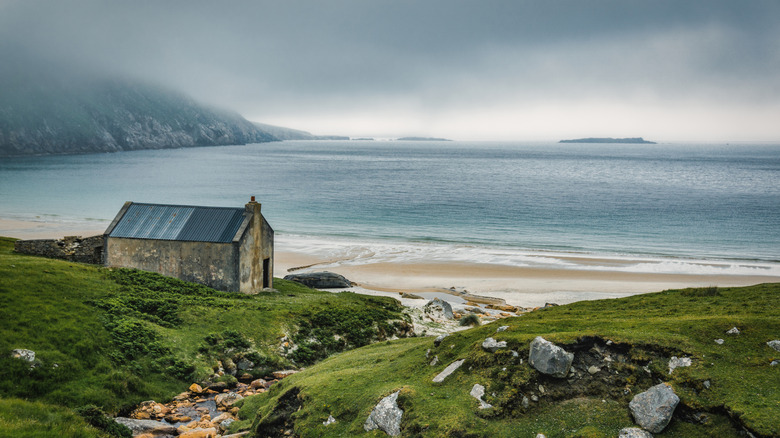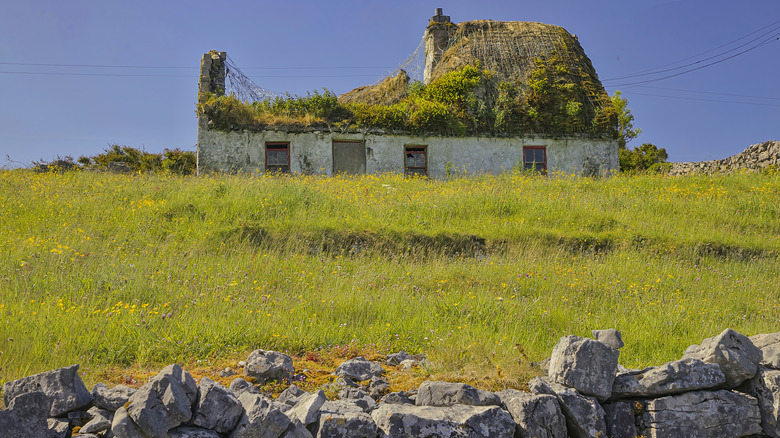If You Fancy A Permanent Vacation, Ireland Will Pay You To Move To These Remote, Lush Emerald Islands
Ever mulled over the idea of swapping the hectic pace of the city for the quiet peacefulness of a remote Irish island? Your dream could turn into reality as long as you're willing to roll up your sleeves and renovate an abandoned property in any of Ireland's remote islands. It's a tempting offer, especially for a place that ranks among the best European countries to visit in 2025. The cherry on top of the cake: The Irish government will hand you anywhere between €50,000 and €84,000 to do so in your choice of any of the program's 23 qualifying offshore islands.
In 2022, the Irish government launched the Vacant Property Refurbishment Grant as an incentive to drive up the population and revitalize neglected properties across the Irish islands and consequently ensure growth and continuity in terms of community, infrastructure, and cultural heritage. The scheme is fairly straightforward: Reviving vacant mainland properties into functional and habitable homes can fetch a €50,000 to €70,000 grant, while island properties considered uninhabitable due to extreme structural damage can claim up to €84,000. If you're up for this adventure but aren't Irish, you'll be pleased to know that purchasing property and, in consequence, applying for the grant are possible for non-Irish citizens as well. But don't expect a fast track to citizenship — the standard immigration rules of residency in Ireland will still apply accordingly.
The beauty and remoteness of Ireland's offshore islands
The combined population of Ireland's offshore islands in a 2016 census count totaled a mere 2,734 people. Spanning five counties, the islands have a varying number of inhabitants, from as many as nearly 1,000 residents in Galway's Inis Mór (one of the filming locations for the movie "The Banshees of Inisherin") to as few as three (yes, three) in Mayo County's privately owned Clynish Island. This cumulative number may be shockingly small, but this is exactly what the grant — which is part of Our Living Islands, a 10-year policy focused on coastal island revitalization — is hoping to solve.
Spoiled with dramatic landscapes and not far from one of the world's longest defined coastal routes, Ireland's offshore islands are enchanting sites with their own special appeal and attractions. Travel guru Rick Steves marveled at the "end of the world" vibes the rugged islands emanate. Visitors to Bere Island are graced with sightings of orca whales, sharks, and dolphins, while Clare Island has some of the most beautiful sea cliffs to walk along. But compared to the mainland, access to these remote islands proves difficult. Getting to any of Ireland's islands depends on ferries and flights (though a plane ride from Connemara Airport to the Aran Islands via Aer Arann takes less than 10 minutes), good docks, and unpredictable weather. Because of this, a house restoration in the Emerald Isle may present certain challenges, especially when it comes to bringing in supplies and manpower.
The fine print involved in renovating your Irish island home
To qualify for the grant, the renovated dwelling must become your primary residence after the works have been carried out or should be placed on the rental market to attract new residents to the island. Buildings built only before 2008 and left uninhabited for at least two years are the other qualifying factors for receiving the grant money. The Residential Tenancies Board will also require a yearly proof of your residential status on the island. You'll also be unable to sell your property until after 10 years; otherwise, you will need to pay back the grant money.
Feedback from several grant recipients has been simultaneously hopeful and sobering. The enthusiasm for the renovation opportunity is tempered by the expenses of materials, labor, and transportation costs that come with an island renovation. "The grant is fantastic, there's no doubt about that, and it's probably the difference between doing it and not doing it," says Bere Island grant recipient Angela O'Sullivan in an interview with The Times. "But I put a couple of hundred thousand into it, so the grant doesn't even come close to covering the full price."
In Inishbofin, the glaring lack of basic conveniences and incentives such as proper docks, stable internet connections, and regular mainland-to-island transportation may explain why its population dropped from 175 in 2016 to a mere 16 inhabitants in 2022. However, if you don't mind making some sacrifices, life on an Irish island could be yours.


